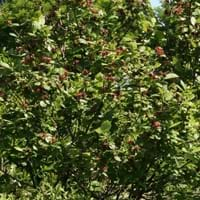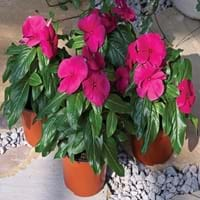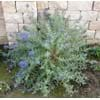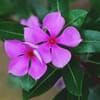Life Span
Perennial
Annual
Type
Shrub
Tender Perennial
Origin
Hybrid origin
Hybrid origin, Madagascar
Types
Calycanthus floridus floridus, Calycanthus floridus glaucus
not available
Number of Varieties
Not Available
Habitat
shaded woods, Woodlands
subtropical regions, Tropical areas
USDA Hardiness Zone
5-8
9-15
Sunset Zone
3a, 3b, 4, 5, 6, 7, 8, 9, 14, 15, 16, 17, 18, 20, 21, 22
A1, A2, A3, H1, H2, 1a, 1b, 2a, 2b, 3a, 3b, 4, 5, 6, 7, 8, 9, 10, 11, 12, 13, 14, 15, 16, 17, 18, 19, 20, 21, 22, 23, 24
Habit
Spreading
Oval or Rounded
Flower Color
White, Light Yellow, Violet
Red, Pink, Peach
Flower Color Modifier
Bicolor
Bicolor
Fruit Color
Green
Not Available
Leaf Color in Spring
Green
Dark Green
Leaf Color in Summer
Green, Dark Green
Dark Green
Leaf Color in Fall
Yellow, Light Yellow, Gold
Dark Green
Leaf Color in Winter
Not Available
Dark Green
Leaf Shape
Lobed
Elliptic and Ovate
Plant Season
Spring, Summer, Fall
Spring, Summer, Fall, Winter
Sunlight
Full Sun, Partial Sun, Partial shade
Full Sun, Partial Sun
Type of Soil
Clay, Loam, Sand
Clay, Loam, Sand
The pH of Soil
Acidic, Neutral
Neutral, Alkaline
Soil Drainage
Well drained
Well drained
Bloom Time
Late Spring, Early Summer
Indeterminate
Tolerances
Drought, Shade areas
Pollution, Drought, Salt
Where to Plant?
Ground
Ground, Pot
How to Plant?
Cuttings, Divison, Seedlings, Suckers
Cuttings, Seedlings
Plant Maintenance
Low
Medium
Watering Requirements
Requires regular watering
Do not water excessively, Needs less watering, Needs small amount of water
In Summer
Lots of watering
Lots of watering
In Spring
Moderate
Moderate
In Winter
Average Water
Average Water
Soil pH
Acidic, Neutral
Neutral, Alkaline
Soil Type
Clay, Loam, Sand
Clay, Loam, Sand
Soil Drainage Capacity
Well drained
Well drained
Sun Exposure
Full Sun, Partial Sun, Partial shade
Full Sun, Partial Sun
Pruning
Remove damaged leaves, Remove dead branches, Remove dead flowers, Remove dead leaves
Remove damaged leaves, Remove dead branches, Remove dead leaves
Fertilizers
All-Purpose Liquid Fertilizer
All-Purpose Liquid Fertilizer
Pests and Diseases
Bacterial Gall, Powdery mildew
aster yellow, Leaf spot, Red blotch, Root rot, Slugs, Snails, Stem rot
Plant Tolerance
Drought, Shade areas
Drought, Pollution, Salt
Flower Petal Number
Semi-Double
Single
Fragrant Bark/Stem
Yes
No
Foliage Texture
Medium
Medium
Foliage Sheen
Glossy
Glossy
Attracts
Birds, Insects, Not Available
Butterflies
Allergy
Toxic if not prepared properly
Toxic if not prepared properly
Aesthetic Uses
Beautification, Cottage Garden
Beautification, Borders, Decorating walls, Ground Cover, Hanging Basket, Used for decorating walls, fences, gates, hedges, etc.
Beauty Benefits
Not Available
Not Available
Edible Uses
Yes
Sometimes
Environmental Uses
Air purification
Air purification, Food for animals, Food for birds
Medicinal Uses
Antispasmodic, Cardiac, Disinfectant, Diuretic
Cancer, Diabetes, Hodgkin's lymphoma., Leukemia, Sore throat
Part of Plant Used
Bark, Root
Flowering Tips, Leaves, stalk
Other Uses
Culinary use, Disinfectant, Repellent
Decoration Purposes, Showy Purposes, Traditional medicine, Use in Chinese herbology
Used As Indoor Plant
No
Sometimes
Used As Outdoor Plant
Yes
Yes
Garden Design
Feature Plant, Foundation, Mixed Border, Screening, Wind Break
Bedding Plant, Container, Hanging Basket, Mixed Border, Tropical
Botanical Name
Calycanthus floridus
CATHARANTHUS roseus
Common Name
Sweetshrub
Cooler Apricot Vinca, Madagascar Periwinkle, Vinca
In Hindi
sweetshrub
Vinca
In German
sweetshrub
Rosafarbene Catharanthe
In French
sweetshrub
Pervenche de Madagascar
In Spanish
sweetshrub
Catharanthus roseus
In Greek
sweetshrub
Catharanthus roseus
In Portuguese
sweetshrub
Catharanthus roseus
In Polish
sweetshrub
Katarantus różowy
In Latin
sweetshrub
Catharanthus roseus
Phylum
Magnoliophyta
Tracheophyta
Class
Magnoliopsida
Magnoliopsida
Order
Laurales
Gentianales
Family
Calycanthaceae
Apocynaceae
Genus
Calycanthus
Catharanthus
Clade
Angiosperms, Magnoliids
Angiosperms, Asterids, Eudicots
Tribe
Not Available
Vicieae
Subfamily
Not Available
Rauvolfioideae
Season and Care of Sweetshrub and Madagascar Periwinkle
Season and care of Sweetshrub and Madagascar Periwinkle is important to know. While considering everything about Sweetshrub and Madagascar Periwinkle Care, growing season is an essential factor. Sweetshrub season is Spring, Summer and Fall and Madagascar Periwinkle season is Spring, Summer and Fall. The type of soil for Sweetshrub is Clay, Loam, Sand and for Madagascar Periwinkle is Clay, Loam, Sand while the PH of soil for Sweetshrub is Acidic, Neutral and for Madagascar Periwinkle is Neutral, Alkaline.
Sweetshrub and Madagascar Periwinkle Physical Information
Sweetshrub and Madagascar Periwinkle physical information is very important for comparison. Sweetshrub height is 180.00 cm and width 240.00 cm whereas Madagascar Periwinkle height is 25.40 cm and width 15.20 cm. The color specification of Sweetshrub and Madagascar Periwinkle are as follows:
Sweetshrub flower color: White, Light Yellow and Violet
Sweetshrub leaf color: Green
Madagascar Periwinkle flower color: Red, Pink and Peach
- Madagascar Periwinkle leaf color: Dark Green
Care of Sweetshrub and Madagascar Periwinkle
Care of Sweetshrub and Madagascar Periwinkle include pruning, fertilizers, watering etc. Sweetshrub pruning is done Remove damaged leaves, Remove dead branches, Remove dead flowers and Remove dead leaves and Madagascar Periwinkle pruning is done Remove damaged leaves, Remove dead branches and Remove dead leaves. In summer Sweetshrub needs Lots of watering and in winter, it needs Average Water. Whereas, in summer Madagascar Periwinkle needs Lots of watering and in winter, it needs Average Water.





